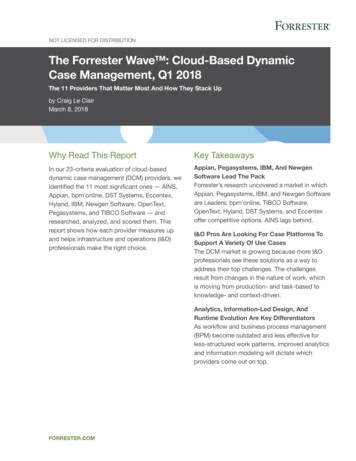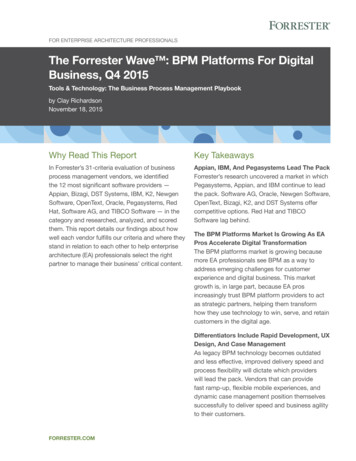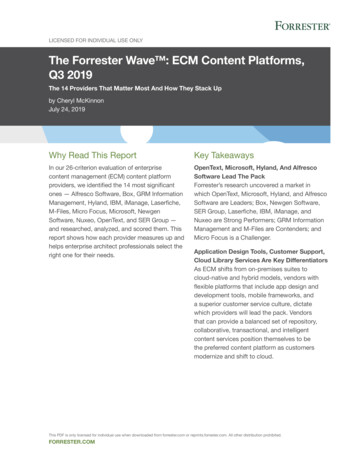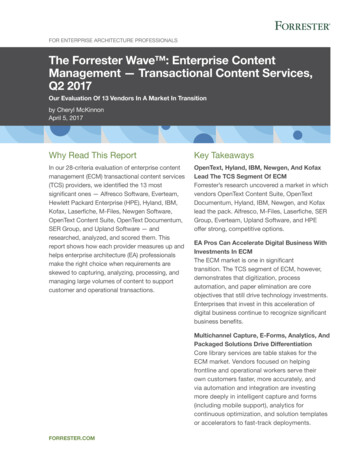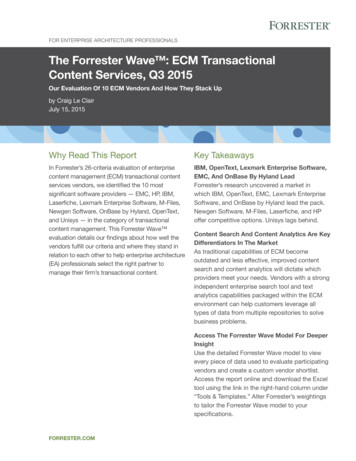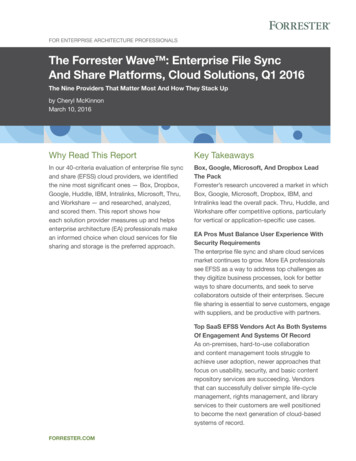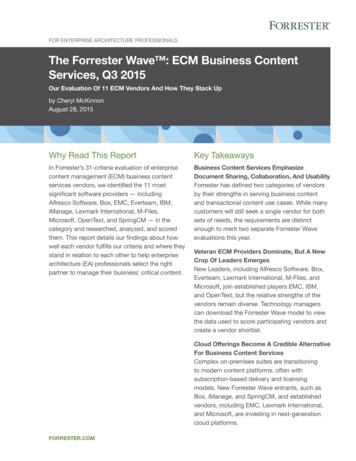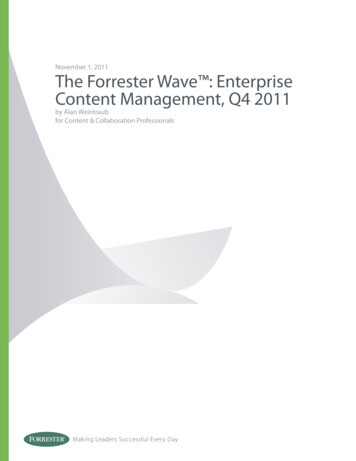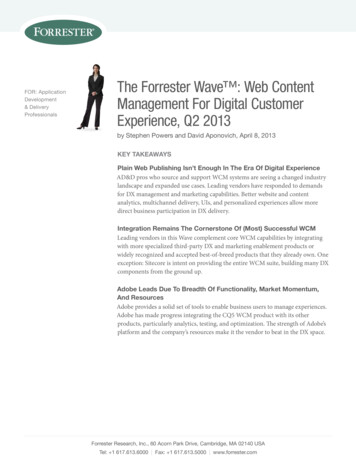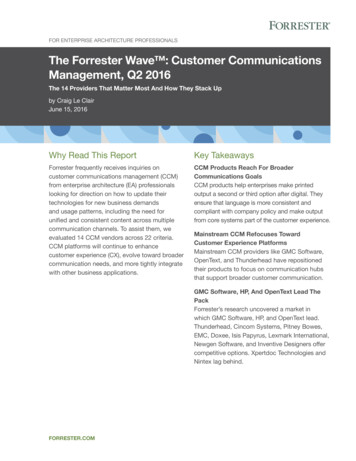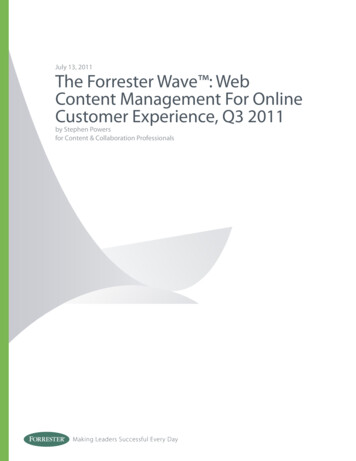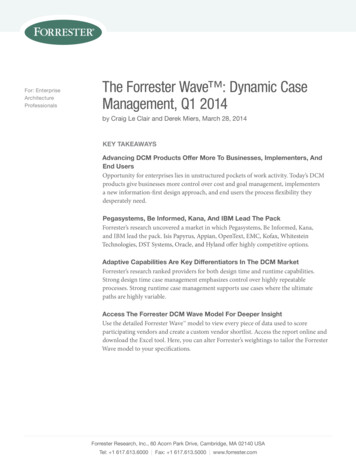
Transcription
For: EnterpriseArchitectureProfessionalsThe Forrester Wave : Dynamic CaseManagement, Q1 2014by Craig Le Clair and Derek Miers, March 28, 2014Key TakeawaysAdvancing DCM Products Offer More To Businesses, Implementers, AndEnd UsersOpportunity for enterprises lies in unstructured pockets of work activity. Today’s DCMproducts give businesses more control over cost and goal management, implementersa new information-first design approach, and end users the process flexibility theydesperately need.Pegasystems, Be Informed, Kana, And IBM Lead The PackForrester’s research uncovered a market in which Pegasystems, Be Informed, Kana,and IBM lead the pack. Isis Papyrus, Appian, OpenText, EMC, Kofax, WhitesteinTechnologies, DST Systems, Oracle, and Hyland offer highly competitive options.Adaptive Capabilities Are Key Differentiators In The DCM MarketForrester’s research ranked providers for both design time and runtime capabilities.Strong design time case management emphasizes control over highly repeatableprocesses. Strong runtime case management supports use cases where the ultimatepaths are highly variable.Access The Forrester DCM Wave Model For Deeper InsightUse the detailed Forrester Wave model to view every piece of data used to scoreparticipating vendors and create a custom vendor shortlist. Access the report online anddownload the Excel tool. Here, you can alter Forrester’s weightings to tailor the ForresterWave model to your specifications.Forrester Research, Inc., 60 Acorn Park Drive, Cambridge, MA 02140 USATel: 1 617.613.6000 Fax: 1 617.613.5000 www.forrester.com
For Enterprise Architecture ProfessionalsMarch 28, 2014The Forrester Wave : Dynamic Case Management, Q1 2014Design Time And Runtime Features Differentiate The Leadersby Craig Le Clair and Derek Mierswith Alex Cullen and Julian KeenanWhy Read This ReportIn Forrester’s 38-criteria evaluation of dynamic case management (DCM) vendors, we identified,researched, analyzed, and scored the 13 most significant software providers — Pegasystems, Be Informed,Kana Software, IBM, Isis Papyrus, Appian, OpenText, EMC, Kofax, Whitestein Technologies, DST Systems,Oracle, and Hyland Software. This research highlights emerging adaptive features that will help enterprisestackle increasing volumes of varied and unstructured work. To do this we evaluated vendors in twocategories reflecting these new features: design time and runtime. Pegasystems, Be Informed, Kana, andIBM were Leaders in overall capabilities with balanced strengths across both design time and runtimecapabilities. This report details our findings on how well each vendor fulfills our criteria and where itstands in relation to other vendors in these categories to help enterprise architects select the right solutionto support launching and scaling enterprisewide DCM.Table Of ContentsNotes & Resources2 Our Dynamic Case Management EvaluationApproachForrester conducted full-day lab-basedproduct evaluations in December 2013. Wealso interviewed 15 vendors and 30 usercompanies.Design Time Case Management EmphasizesAnd Delivers ControlRuntime Case Management Supports UseCases Where Work Is Highly VariableBuyers Focus On Current Offerings, FutureVision, And Strength Of Installed BaseEvaluated Vendors6 Evaluation Analysis13 Vendor ProfilesLeaders Emphasize Dynamic CapabilitiesRelated Research DocumentsKnowledge Work Pushes Dynamic CaseManagement MarketMarch 28, 2014Smart Process Apps — One Year LaterDecember 10, 2013Dynamic Case Management — An Old IdeaCatches New FireDecember 28, 2009Strong Performers Emphasize Either Runtime OrDesign Time CapabilitiesContenders Emphasize A Strong Base OfCustomers17 Supplemental Material 2014, Forrester Research, Inc. All rights reserved. Unauthorized reproduction is strictly prohibited. Information is based on best availableresources. Opinions reflect judgment at the time and are subject to change. Forrester , Technographics , Forrester Wave, RoleView, TechRadar,and Total Economic Impact are trademarks of Forrester Research, Inc. All other trademarks are the property of their respective companies. Topurchase reprints of this document, please email clientsupport@forrester.com. For additional information, go to www.forrester.com.
For Enterprise Architecture Professionals2The Forrester Wave : Dynamic Case Management, Q1 2014Our Dynamic Case Management Evaluation ApproachTo assess the state of the DCM market and see how the vendors stack up against each other,Forrester evaluated the strengths and weaknesses of top DCM vendors. Our goal in this evaluationwas to highlight emerging adaptive features that will help enterprises tackle increasing volumesof varied and unstructured work. To do this we have evaluated vendors in both design time andruntime categories.1 As we do not, except in rare cases, recommend an enterprise purchase twoDCM platforms, we also provide an overall ranking.Design Time Case Management Emphasizes And Delivers ControlOlder process automation approaches, based on traditional production concepts with clearlyarticulated paths, still drive most enterprises. Yet these approaches struggle to support the flexibilityrequired by emerging customer-centric activities. As jobs get smarter, enterprises have fewer skilledresources that must tackle more varied and complex work. They require controlled yet adaptablemechanisms to deliver better customer experiences and, at the same time, meet new demands fromregulators, auditors, and litigants. Design time case management: Assumes 90% of what the user will do is designed ahead of time. Design time use cases tendto be more production oriented. For example, consider exception management for financialtransactions. Case workers have some flexibility by adding new tasks or involving other users,but the overall process flow is well defined and repeats often. Criteria critical for design timeuse cases emphasize the development environment and production case management criteria. Is controlled and auditable. Traditional business process management (BPM)implementations tend to lock users within a set of screens and forms. When context andexceptions become complex, work gets stuck. The only avenue is to break out of the prescribedprocess — into email, sticky notes, spreadsheets, and phone calls. Standardization, control,transparency, and auditing are largely lost for these “out of process” activities. Criteria criticalfor design time use cases maintains work within case process boundaries. Provides pre-defined and controlled mechanisms to handle variation. Case context canvary considerably, so employees need ways of changing how cases are handled, using theirskills and expertise. But design time, as opposed to runtime, wants to limit or control thatflexibility. Simple task reassignment is one such facility, but products also include the ability todynamically select predefined tasks or associate new process fragments at runtime. In addition,design time DCM platforms must have strong integration to underlying data and systems,delivering information to the case worker progressively and in context for each state. As thecontext for a given state changes, strong design time DCM products capture documents andevents and update the work, potentially kicking off other process fragments or firing contextspecific business rules. 2014, Forrester Research, Inc. Reproduction ProhibitedMarch 28, 2014
For Enterprise Architecture Professionals3The Forrester Wave : Dynamic Case Management, Q1 2014Runtime Case Management Supports Use Cases Where Work Is Highly VariableCreative and unpredictable work efforts still retain structure. Even Jackson Pollock, the prominentabstract painter, needed to select the right canvas, choose a floor location, select which paintcans to drip, and determine the best order. The opportunity for enterprises today lies in similarunstructured pockets of activity, where exceptional service thrives, as does high costs and risks tothe business. Runtime case management: Allows behavior to evolve during a running process. These approaches allow users to meetemergent requirements and independently add features as they need them. The end user cancreate tasks, add users to the process, alter business rules, and collaborate with peers in realtime. These emergent approaches take the pressure off designing all capabilities ahead of time,minimizing upfront process discovery, relying on flexibility in the platform to handle exceptions. Supports an increasing volume of knowledge work. There are now far fewer productionworkers, such as those that perform repetitive tasks like data entry and responding to simpleinformation requests. Relentless offshoring, automation, and customer self-service are slowlyeliminating the need for these types of workers. We consistently hear feedback, such as “Today,70% of our inquiries are handled by self-service [interactive voice response, Web, or mobile]with only 30% ever getting to our call center. Unfortunately, the number of agents we needhas not decreased due to how complex these calls are.” (VP of workforce planning, majortelecommunications company) Supports flatter organizations and the projected increase in unstructured work patterns.Process management is changing. Current process approaches supported by traditional BPMand typical process models are too complicated to design with the business. They tend toreflect an antiquated organizational hierarchy that is becoming obsolete.2 Flat organizations useinformation sharing tools that change the nature of work, lead to more unstructured peer-topeer communication, and make the combination of tasks and information context central toprocess outcomes. Provides a strong goal versus task orientation. Trends in performance management stressthe importance of metrics that allow automated measurement against tactical goals. Moreover,the business wants to map operational goals to financial and strategic objectives across theenterprise.3 In addition, leading organizations are managing performance with goals that spanfunctional and organizational processes — metrics that map to the customer or business value.With modern DCM platforms, a business can now design a process based on goals with lessdependence on specific task completion. Several providers have built strong constructs forgoal management allowing goals to link to pre-conditions and rules, alongside traditional taskcompletion. 2014, Forrester Research, Inc. Reproduction ProhibitedMarch 28, 2014
For Enterprise Architecture Professionals4The Forrester Wave : Dynamic Case Management, Q1 2014Buyers Focus On Current Offerings, Future Vision, And Strength Of Installed BaseAs a buyer considering DCM offerings, you have a diverse range of solution providers to choosefrom. For this report, Forrester used a comprehensive set of case-management-specific evaluationcriteria to compare DCM solutions vendors. Forrester also examined past research, user needsassessments, and vendor and expert interviews. We organized the criteria for this Forrester Waveevaluation into three high-level categories: Current offerings. We looked at the strength of the vendors’ products across a wide spectrumof DCM capabilities. We evaluated the product’s architecture, its support for case phases/milestones, service-level agreement (SLAs), deadlines and dependencies, sophisticatedorganizational models, deployment options, event handling, and the overall execution approach.We also looked at support for analytics, ease of user interface development, and enterprisecontent management (ECM) capabilities. Strategy. We looked at the strength of each vendor’s product strategy and vision, and how itintends to support increasingly complex customer requirements. We also explored the go-tomarket strategy for each vendor, assessing its degree of focus on DCM needs. Market presence. We gauged the size of the vendor’s customer base and evaluated the depth ofhuman and financial resources available to enhance its products and serve customers. Marketpresence in this report reflects the relative importance of each DCM solution vendor within theoverall DCM solutions market.Evaluated VendorsForrester included 13 vendors in the assessment. Each vendor has met four main criteria forinclusion in this Forrester Wave evaluation (see Figure 1): They are often discussed in client inquiries and appear on client vendor selection shortlists. Their solutions are widely applicable to use cases across three main case management categories:investigative, incident management, and service requests, which demonstrate a horizontal casemanagement platform. They demonstrate innovative approaches to dynamic case management. Their solutions include significant proprietary capabilities in key areas of technology fordynamic case management — for example, BPM, ECM, social technologies, and analytics. 2014, Forrester Research, Inc. Reproduction ProhibitedMarch 28, 2014
For Enterprise Architecture Professionals5The Forrester Wave : Dynamic Case Management, Q1 2014Figure 1 Evaluated Vendors: Product Information And Selection CriteriaProduct versionevaluatedVersionrelease date7.3October 20134.2.4October 2013VendorProduct evaluatedAppianAppian BPM SuiteBe InformedBe Informed Business ProcessPlatformDST SystemsAWD10EMCEMC Documentum xCP2.1February 2014HylandOnBase13July 2013IBMIBM Case Manager5.2October 2013Isis PapyrusPapyrus Platform (includingFramework Solution for ACM)7.1September 2013KanaKana Enterprise13April 2013KofaxKofax TotalAgility7October 2013OpenTextOpenText CordysOpenText BPM EverywhereOpenText Process IntelligenceOpenText Cordys ProcessComponent LibraryOracleOracle BPM Suite 11gPegasystemsPega Dynamic Case ManagementWhitesteinTechnologiesLiving Systems Process Suite74.310.5managerView 3.1June 2013October 2013May 2013November 2012November 201311.1.1.7April 20137July 20132.7October 2013Inclusion criteriaVendors are often discussed in client inquiries and appear on client vendor selection shortlists.Their solutions are widely applicable to use cases across three main case management categories:investigative, incident management, and service requests, which demonstrate a horizontal casemanagement platform.They demonstrate innovative approaches to dynamic case management.Their solutions include significant proprietary capabilities in key areas of technology for dynamic casemanagement — for example, BPM, ECM, social technologies, and analytics.Source: Forrester Research, Inc. 2014, Forrester Research, Inc. Reproduction ProhibitedMarch 28, 2014
For Enterprise Architecture Professionals6The Forrester Wave : Dynamic Case Management, Q1 2014Evaluation AnalysisOur goal in this evaluation is to highlight emerging adaptive features that will help enterprisestackle increasing volumes of varied and unstructured work. To do this we have rated vendors inboth design time and runtime categories.4 All providers have both design time and runtime features.Yet, market focus, product features, and architectures make some products more adaptive, whileothers stronger for use cases where adaptation is less important than control. To be clear: Strong design time case management emphasizes and delivers control. This capabilityassumes that 90% or more of what the user will do is developed, tested, and deployed prior touser getting started. Case workers have less flexibility, e.g., adding new tasks or involving otherusers, and the overall process flow is well defined and more repeatable. Criteria supportingdesign time were weighted more highly in this ranking including the development environmentand production case management criteria. These use cases tend to be more production oriented;for example, managing exceptions for financial transactions (see Figure 2). Strong runtime case management support use cases where work is highly variable. The caseunfolds over time is far less predictable. The case view is altered by user actions and systemevents, with users who are able to add tasks, processes, and participants on the fly at the point ofneed. Criteria supporting runtime case management were weighted more highly in this ranking,including user-centered design, runtime evolution, support for goals, and data management(see Figure 3).Since we do not believe an enterprise should choose two DCM platforms, we have also included anoverall ranking that provides a more balanced weighting across both runtime and design time (seeFigure 4). We intend this evaluation of the dynamic case management market as a starting pointonly. We strongly encourage readers to view detailed product evaluations and then extend the list ofvendors, and to include some of these criteria, or adapt the criteria weightings, to fit their individualneeds through the Forrester Wave Excel-based vendor comparison tool. 2014, Forrester Research, Inc. Reproduction ProhibitedMarch 28, 2014
For Enterprise Architecture Professionals7The Forrester Wave : Dynamic Case Management, Q1 2014Figure 2 Forrester Wave : Dynamic Case Management: Design Time Capabilities, Q1 ongBe InformedAppianWhitestein EMCIsis PapyrusDST SystemsKofaxCurrentofferingGo to Forrester.com todownload the ForresterWave tool for moredetailed productevaluations, featurecomparisons, andcustomizable rankings.Market presenceWeakWeakStrategyStrongSource: Forrester Research, Inc. 2014, Forrester Research, Inc. Reproduction ProhibitedMarch 28, 2014
For Enterprise Architecture Professionals8The Forrester Wave : Dynamic Case Management, Q1 2014Forrester’sWeightingAppianBe InformedDST SystemsEMCHylandIBMIsis n TechnologiesFigure 2 Forrester Wave : Dynamic Case Management: Design Time Capabilities, Q1 ‘14 (Cont.)CURRENT OFFERINGArchitectureContent managementAnalyticsUser interfaceDeploymentDesign TRATEGYProduct strategyDCM go-to-marketstrategyProduct cost50%50%50%3.00 3.50 3.00 3.00 2.50 3.50 3.00 3.50 3.50 3.00 2.50 4.00 3.003.00 3.00 2.00 3.00 2.00 4.00 4.00 3.00 3.00 3.00 2.00 4.00 4.003.00 4.00 4.00 3.00 3.00 3.00 2.00 4.00 4.00 3.00 3.00 4.00 2.000%0.00 0.00 0.00 0.00 0.00 0.00 0.00 0.00 0.00 0.00 0.00 0.00 0.00MARKET PRESENCEThis version’sinstalled baseThis product’sinstalled baseRevenue0%34%3.00 1.67 2.67 3.34 2.67 4.00 2.00 2.33 2.33 2.34 2.67 3.99 1.333.00 2.00 3.00 4.00 3.00 4.00 2.00 2.00 2.00 3.00 3.00 3.00 1.0033%3.00 1.00 2.00 3.00 2.00 4.00 2.00 2.00 3.00 2.00 2.00 4.00 1.0033%3.00 2.00 3.00 3.00 3.00 4.00 2.00 3.00 2.00 2.00 3.00 5.00 2.00All scores are based on a scale of 0 (weak) to 5 (strong).Source: Forrester Research, Inc. 2014, Forrester Research, Inc. Reproduction ProhibitedMarch 28, 2014
For Enterprise Architecture Professionals9The Forrester Wave : Dynamic Case Management, Q1 2014Figure 3 Forrester Wave : Dynamic Case Management: Runtime Capabilities, Q1 ongIsis PapyrusBe InformedPegasystemsAppianEMCWhitestein aIBMGo to Forrester.com todownload the ForresterWave tool for moredetailed productevaluations, featurecomparisons, andcustomizable rankings.KofaxDST SystemsMarket presenceWeakWeakStrategyStrongSource: Forrester Research, Inc. 2014, Forrester Research, Inc. Reproduction ProhibitedMarch 28, 2014
For Enterprise Architecture Professionals10The Forrester Wave : Dynamic Case Management, Q1 2014Forrester’sWeightingAppianBe InformedDST Sys
Mar 02, 2014 · the Forrester Wave Dynamic case Management, 1 2014 2 2014, Forrester research, inc. reproduction prohibited March 28, 2014 OUR DynaMIC Case ManageMenT eVaLUaTIOn aPPROaCh To assess the state of the DCM market and see how the vendors stack up against each other, Forrester e
